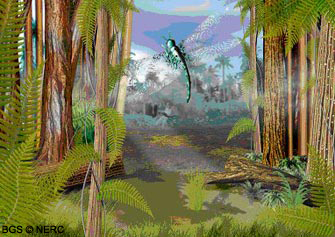
Ancient environments
Silurian l Devonian l Carboniferous l Triassic l Jurassic
Life in the Late Carboniferous, 326 – 299 million years ago

In the Late Carboniferous, quartzitic sandstones spread across the Mendip area, ending the growth of the Early Carboniferous limestone succession. Eventually a vast delta was formed, stretching from Britain eastwards to Poland, crossed by a winding network of river channels, and colonised by lush swamp forests of giant tree ferns. Decaying plant remains formed thick peat deposits, and these were deeply buried, compacted, and transformed into coal.
At Kilmersdon and Writhlington, near Radstock, discarded rock from coal mining contains the exquisite remains (stems, foliage & seed pods) of fossil plants such as Lepidodendron and Calamites, and more rarely, insects. Unlike modern trees, there was no woody tissue to support these plants. Some grew as featureless trunks, only producing a tree-like crown of branches when fully mature. Others, such as Calamites, resembled the modern-day horsetails, but grew to perhaps 10 m in height.
Periodically, the sea flooded into the coal swamps, killing the vegetation and depositing thin beds of mudstone containing marine fossils. These are called 'marine bands', and are very useful for understanding the relative ages of coal-bearing rocks.
Each marine band contains particular fossils that allow its recognition, and are individually named, usually after a particularly characteristic fossil. Near Westbury-sub-Mendip, the Subcrenatum Marine Band has been recognised, characterised by the goniatite Gastrioceras subcrenatum. Goniatites resemble ammonites that inhabited the seas of the Jurassic and Cretaceous, but are more primitive, typically with globose shells and simplified ornamentation.
- Home
- Overview maps
- Locality
areas
- Cheddar Gorge
- Charterhouse
- Blackdown
- Burrington Combe
- Shipham & Rowberrow
- Crook Peak & Axbridge
- Banwell to Churchill
- Priddy
- Harptree & Smitham Hill
- Draycott & Westbury-sub-Mendip
- Wookey Hole & Ebbor Gorge
- Wells
- Great Elm & Vallis Vale
- Mells & the Wadbury Valley
- The Vobster area
- The Whatley area
- Torr Works & Asham Wood
- Beacon Hill
- Stoke St Michael & Oakhill
- Holwell & Nunney
- Shepton Mallet & Maesbury
- Gurney Slade & Emborough
- The Nettlebridge valley
- Geology
- Minerals and mines
- Quarrying
- Caves and karst
- Biodiversity
- Detailed site information
- Acknowledgements
- External links
- Search
- Site map